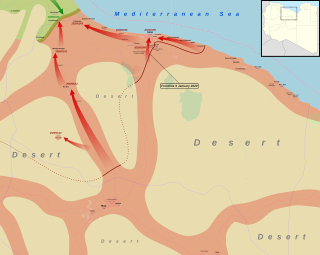
Tripoli International Airport is a closed international airport built to serve Tripoli, the capital city of Libya. The airport is located in the area of Qasr bin Ghashir, 24 kilometres (15 mi) from central Tripoli. It used to be the hub for Libyan Airlines, Afriqiyah Airways, and Buraq Air.
Tarhuna, also Tarhoona or Tarhunah, is a Libyan village 65 kilometres (40 mi) to the southeast of Tripoli, in the Murqub District. The Tarhuna District, including the city of Msallata, had an urban population of about 296,000. The population in Tarhuna proper was calculated to be 13,264 in 2011.

The Libyan Army is the brand for a number of separate military forces in Libya, which were under the command of the internationally recognised Government of National Accord (GNA) and the Government of National Unity.

The Libyan National Army or the Libyan Arab Army is a component of Libya's military forces which were nominally a unified national force under the command of Field Marshal Khalifa Haftar when he was nominated to the role on 2 March 2015 by the House of Representatives, consisting at the time of a ground force, an air force and a navy.

Gaddafi loyalism, in a wider political and social sense also known as the Green resistance, consists of sympathetic sentiment towards the overthrown government of Muammar Gaddafi, who was killed in October 2011, and his Third International Theory. Despite Muammar Gaddafi's death, his legacy and Jamahiriya ideology still maintains a popular appeal both inside and outside Libya into the present day. Regardless, the Western sentiment has largely been that this continued support may contribute to some of the ongoing violence in Libya.

The Libyan civil war (2014–2020), also more commonly known as the Second Libyan Civil War, was a multilateral civil war which was fought in Libya between a number of armed groups, but mainly the House of Representatives (HoR) and the Government of National Accord, for six years from 2014 to 2020.

The National Salvation Government was a government body formed by politicians from the General National Congress's blocs that lost the June 2014 elections in Libya. The NSG was led by Khalifa al-Ghawil. The term Libya Dawn Coalition was used to refer to the armed groups and the wider political movement supporting the NSG. The NSG was one of the major sides in the Second Libyan Civil War from its formation August 2014 until its dissolution in April 2016.

The Libyan Crisis is the current humanitarian crisis and political-military instability occurring in Libya, beginning with the Arab Spring protests of 2011, which led to two civil wars, foreign military intervention, and the ousting and death of Muammar Gaddafi. The first civil war's aftermath and proliferation of armed groups led to violence and instability across the country, which erupted into renewed civil war in 2014. The second war lasted until October 23, 2020, when all parties agreed to a permanent ceasefire and negotiations.
Khalifa al-Ghawil, sometimes transliterated as Khalifa al-Ghweil or Ghwell, is a Libyan politician. He was the prime minister of the General National Congress-led National Salvation Government in Tripoli.

Fayez Mustafa al-Sarraj is a Libyan politician who served as the Chairman of the Presidential Council of Libya and Head of Government of the Government of National Accord from 2016 to 2021, which was formed on 17 December 2015 under the Libyan Political Agreement. He has been a member of the Parliament of Tripoli.

The Government of National Accord was an interim government for Libya that was formed under the terms of the Libyan Political Agreement, a United Nations–led initiative, signed on 17 December 2015. The agreement was unanimously endorsed by the United Nations Security Council, which welcomed the formation of a Presidency Council for Libya and recognized the Government of National Accord as the sole legitimate executive authority in Libya. On 31 December 2015, Chairman of the Libyan House of Representatives, Aguila Saleh Issa declared his support for the Libyan Political Agreement. The General National Congress has criticized the GNA on multiple fronts as biased in favor of its rival parliament the House of Representatives.
This is a detailed timeline of the Libyan civil war (2014–2020) which lasted from 2014 to 2020.
Clashes occurred in western Libya since 14 October 2016, when a coup d'état attempt was conducted by the former head of the National Salvation Government (GNS), Khalifa al-Ghawil, against Prime Minister Fayez al-Sarraj, the head of Libya's Government of National Accord (GNA). This evolved into fighting between the GNA and GNS for control of Tripoli and parts of western Libya, while pro-GNA militias also attacked other militias for control of the region.

The Western Libya campaign was a military campaign initiated on 4 April 2019 by the Operation Flood of Dignity of the Libyan National Army, which represents the Libyan House of Representatives, to capture the western region of Libya and eventually the capital Tripoli held by the United Nations Security Council-recognised Government of National Accord. The Government of National Accord regained control over all of Tripoli in June 2020 and the LNA forces withdrew from the capital, after fourteen months of fighting.
This is the order of battle for the Western Libya campaign, codenamed "Operation Flood of Dignity" by forces under Field Marshal Khalifa Haftar. The forces supporting Haftar and the House of Representatives, mainly the Libyan National Army, are opposed by the armed forces of the forces loyal to the Government of National Accord, including the Libyan Army and the Tripoli Protection Force.

The Battle of Sirte took place on January 6, 2020 during the Second Libyan Civil War. The Libyan National Army of Marshal Khalifa Haftar took the city from the forces of the Fayez el-Sarraj Government.
Ali Kanna Sulayman is a Libyan lieutenant general of Tuareg origin. He was the commander of Muammar Gaddafi's southern forces in the First Libyan Civil War. After the end of the Fezzan campaign, he fled to Agadez and helped other Gaddafi loyalists, most notably air force commander Ali Sharif Al-Rifi, escape to Niger.
The Battle of Kikla was a confrontation between Zintan Brigades and Fajr Libya in Kikla, Libya between 11 October and 24 November 2014.

Operation Volcano of Anger, alternatively known as Operation Volcano of Rage, was a military resistance campaign launched by the Government of National Accord in Libya to counter the advances of the Libyan National Army led by General Khalifa Haftar. The conflict, which began in April 2019, has witnessed intense fighting around the capital city, Tripoli, and other strategic locations in the country. The operation is part of the broader armed conflict in Libya, marked by shifting alliances, foreign involvement, and a struggle for control over the nation's political future.











